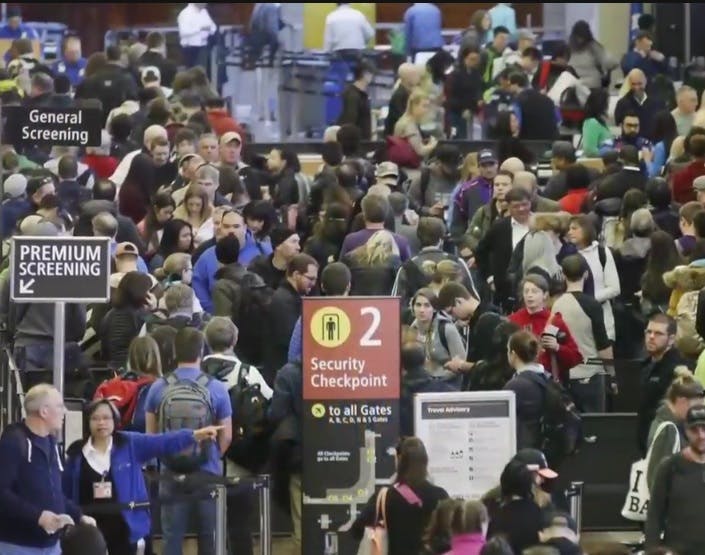Editor’s note: Flying somewhere for the long weekend? After reading this article, you may want to consider taking the train.
While many of us are looking forward to traveling this Memorial Day Weekend, no one is looking forward to waiting in those long security lines at the airport. But you’re not the only ones who are fed up.
The Transportation Safety Administration has been having a hard time lately proving their value. Last year TSA agents logged a 95% failure rate at uncovering mock explosives and banned weapons during an internal investigation, prompting outcry from the public and Congress.
Things got real last week however, when they were blasted by the House Oversight and Government Reform Committee for doling out improper bonuses to high-ranking officials at a time when they are failing almost all operational objectives. TSA Administrator Peter Neffenger found himself trying to defend a workplace culture rife with hostility and intimidation that whistleblowers have compared to “Lord of the Flies.” The benefactor of those improper bonuses, Security Administrator Kelly Hoggan, has since been ousted.
An agency in crisis
Rep. John Mica (R-FL) pointed out that while TSA officials are busy raking in salaries upwards of $180K, they’re “screwing the guy who does the work,” referring to the low-paid airport screeners we’re most familiar with. After a massive cutback of 5,800 workers since 2011, understaffing is creating untenable lines at security checkpoints in major airports.
A video of a ludicrously long line at a TSA checkpoint in O’Hare International recently went viral, prompting American Airlines to declare TSA its “number one problem” after several flights were delayed. To make matters worse, their Congressional hearing was marred by a baggage-screening snafu in Phoenix that left thousands of travelers without their luggage for days.
TSA: Rated a “worst place” to work
Not for nothing, the TSA was recently voted one of the worst places to work in government, ranking at 313 out of 320 agencies, and perennially struggles because of its general mismanagement. In 2015, they lost 4,644 workers while only hiring 373. They were given emergency funding to hire 760 new workers in 2016, but in order to keep up with the increasing number of travelers that number should be more around 6,000. The TSA loses about 100 screeners per week through attrition alone, and has some of the highest turnover rates in government. Many airports are threatening to simply ditch them in favor of private security firms.
Granted, Congress bears a lot of responsibility here for slashing funding and leaving TSA officials with very little to work with, but the agency has been plagued with performance and personnel problems for years. In its first decade of existence, even when its coffers were flush, there were still 25,000 security breaches at U.S. airports.
Don’t let your company become a TSA
It’s hard not to see the mounting evidence that the TSA is, as Rep. Jason Chaffetz (R-UT) put it, an organization “in total failure.” Please don’t do what they do. Here’s how to avoid becoming the TSA:
Have a clear strategy – The TSA bean-counters look for x amount of warm bodies to fill the slots, even while admitting that their training is substandard and that there are “entire layers of security” missing from their process. Establish a clear vision first, then you will have a better idea how to use your workforce. The CATO Institute had some choice words about their current methodology:
The problem is not just operational inefficiency. The TSA doesn’t think strategically, or at least, it does not do so effectively. The agency has been criticized for failing to follow ‘robust risk assessment methodology’ and undertaking ‘little or no evaluation of’ program performance.
Or as Rep. Mica bluntly framed it, “This is not a thinking organization.” So be a thinking organization and think things through before, during, and after.
Don’t insulate the C-suite – The insular attitude among TSA officials set the stage for malfeasance and backroom dealings, giving obscene bonuses to officials whose departments were in utter failure. If you think the American people lost faith when they heard that, imagine how the everyday TSA employees felt. In a highly engaged organization, executives are actively involved with frontline employees, engaging them whenever possible and finding ways to connect the company’s goals to their actions. Most important, they are fair and transparent and it doesn’t take an act of Congress to have a conversation with them.
Live up to your mission – The TSA’s current mission statement reads, “Protect the nation’s transportation systems to ensure freedom of movement for people and commerce,” but it seems to do the exact opposite. The words you choose for your mission statement matter, but not as much as verisimilitude and integrity. Employees are merely captivated by words; honest actions keep them engaged for the long haul.
Landing safely
The fate of the TSA may hang in the balance, but at least we can use the opportunity to examine how things went so wrong. The scandals have forced our society to re-examine the reasons the TSA was created in the first place, and honestly ask if we are in fact safer and freer because of it. In the meantime you can avoid their fate by asking the right questions within your organization, and seeking out honest answers.
